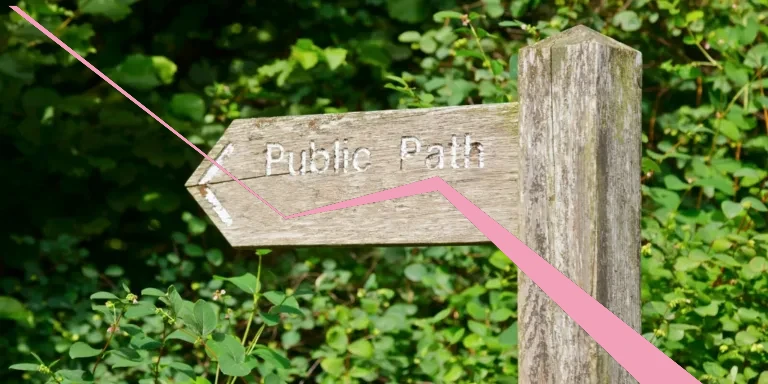Obtaining a public path diversion order is often a balancing act between ensuring privacy for landowners, and keeping an attractive route for walkers.
Explains Lodders’ Highways specialists Michael Orlik and Victoria Longmore.
The ability to obtain a public path diversion order is important to landowners, especially where paths pass close to their homes and they wish to move them away to achieve greater privacy. Conversely, user groups are often concerned that the route of a diversion should not be less attractive, for example, by being taken away from open parkland or buildings of historic interest.
An inspector in considering whether to confirm an order, to which there have been objections, often has to undertake an extremely difficult balancing exercise.
Greater privacy vs. a less attractive route
In a recent case concerning Bodicote Mill near Banbury in Oxfordshire, the inspector pointed out the problems of balancing greater privacy for householders against a less attractive route for users; and the short period of time during which quite a number of users would derive less enjoyment from the path against the benefit to the residents in the Mill, who would be living there the whole time.
It is a balancing exercise which the Courts have said many times must be left to the judgment of the inspector. The Courts will only intervene if the inspector has taken account of irrelevant factors, failed to take account of relevant factors, or made a decision which was so irrational that no reasonable person could have made it. While applications to the High Court to quash decisions do sometimes succeed on the first ground, it is rare for them to do so on the ground of irrationality.
Failing to take into account relevant matters
In the case of the Mill at Bodicote, the Inspector confirmed the order. An application was made to the High Court by the Ramblers Association that the Inspector had failed to take into account two relevant matters (Ramblers Association v Secretary of State and Weston [2012] EWHC 3333). The Association complained that the Inspector had taken no account of the fact that the owners seeking the diversion had been aware of the footpath when they bought the Mill and that if the order was confirmed, it would set an undesirable precedent for diverting paths near other old mills.
Criteria for making a public path diversion
The criteria for making a diversion order are specified in the Highways Act 1980 section 119. The diversion has to be practical and in the interests of either the landowner or the public, and the route must not be substantially less convenient for the public. In considering whether an order should be confirmed, section 119(6) states that regard must be had to the effect:
- of the diversion on the public enjoyment of the path as a whole,
- the order would have on other land served by the path on its existing line,
- on any land over which the diverted route would run.
Setting an undesirable precedent
Mr Justice Ouseley held that, in considering whether it is convenient to make or confirm an order any relevant matters could be taken into consideration. The factors set out in subsection (6) were not exhaustive. The Judge did consider that the issue of precedent might be relevant in some circumstances, but no evidence had been put to the inspector that confirmation of the order in this case would set an undesirable precedent.
As regards the argument that, if the owners purchased the property knowing of the path, their application should be regarded as less persuasive, the judge said that he had “very real doubts” as to its relevance but did not say that it could never be relevant. The judge also held that if the path could be shown to be an ancient historical route, this could be relevant even if a diverted route would be just as enjoyable for the public. Although the Inspector should have considered these matters, on the facts of this case, they would have made no difference to his decision to confirm the diversion order. The Judge refused to quash the decision.
Recent case
In a case heard this year, Open Spaces Society v Secretary of State [2021] EWCA Civ 241, the Court of Appeal has approved Mr Justice Ouseley’s view that the list of matters to be considered in section 119(6) is not exhaustive, and has given further helpful guidance on the construction of section 119 as a whole.
The case concerned an application to divert a footpath from the garden of a property called Manor Farm, a listed building said to date back to 1633. The diversion was for a distance of 228 metres and would take the path out of the garden onto the other side of the garden wall. The inspector found, pursuant to section 119(6), that there would be some loss of enjoyment for the public in not being able to see an interesting building.
Nevertheless, taking account of all the other matters put before him, he decided that, in the interests of the owners, it would be practical to confirm the order. Counsel for the Open Spaces Society argued that, once the inspector has found that there would be adverse effects in relation to any of the three matters set out in subsection (6), the order could not be confirmed. The Court of Appeal rejected this approach. The decision maker must have regard to the matters specified in section 119(6) and to any other relevant matters in reaching his decision as to whether to confirm the order.
Consider the relevant factors
Both decisions suggest that a broad view should be taken of applications to divert public paths. All relevant factors should be considered in carrying out the balancing exercise between the interests of owners and of members of the public using the paths rather than one consideration being determinative.
Obtaining a public path diversion order
Diversions are rarely easy to obtain. As these two cases demonstrate, the Open Spaces Society and the Ramblers Association take a keen interest in them. In accordance with Government guidance, both bodies and the British Horse Society in respect of bridleways, are always consulted before the local authority will make an order. The views of the local parish council are also important. If objections are raised by any of these bodies it is sensible for the landowner to see if they can be met by adjusting the route of the diversion, for example to ensure that a good view is not lost on the new route, or by replacing stiles with kissing gates, before pressing the local authority to make the order.
Once the order is made it must be advertised. If there are any objections at all, the order has to be referred to the Planning Inspectorate for determination after an exchange of written representations or a local inquiry. This adds many months to the procedure with an uncertain outcome; hence the need to negotiate locally with potential objectors if possible.
The local authority will usually require the owner to pay its administrative costs in making and advertising the order and in certifying that the new route is fit for use if the order is confirmed.
Prospects of success
Whilst diversion orders can be made either in the interests of the landowner or the public, landowners would be wise to try to apply for a diversion which will benefit the public as well as themselves. This could significantly increase the prospects of success. Offering a route with better drainage, a wider path, or a route across open land with good views, or closer to a point of interest such as a historic site, could all help.
Get in touch
Lodders’ real estate lawyers provide city expertise and service at an outstanding value. For more information on services the team offer, please get in touch on 01789 293259, or via email.
Contact us
Read more
Other news, insights and events








